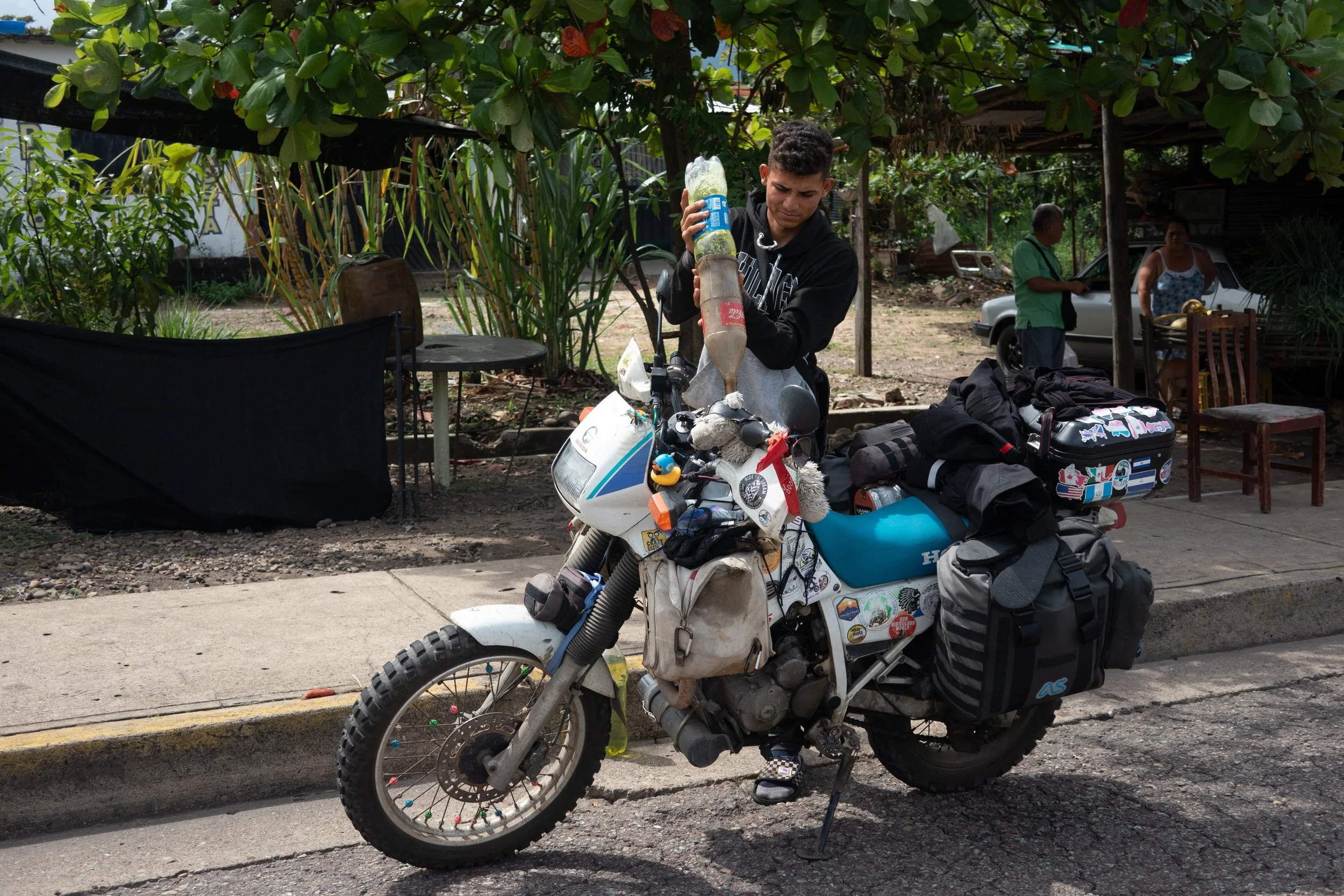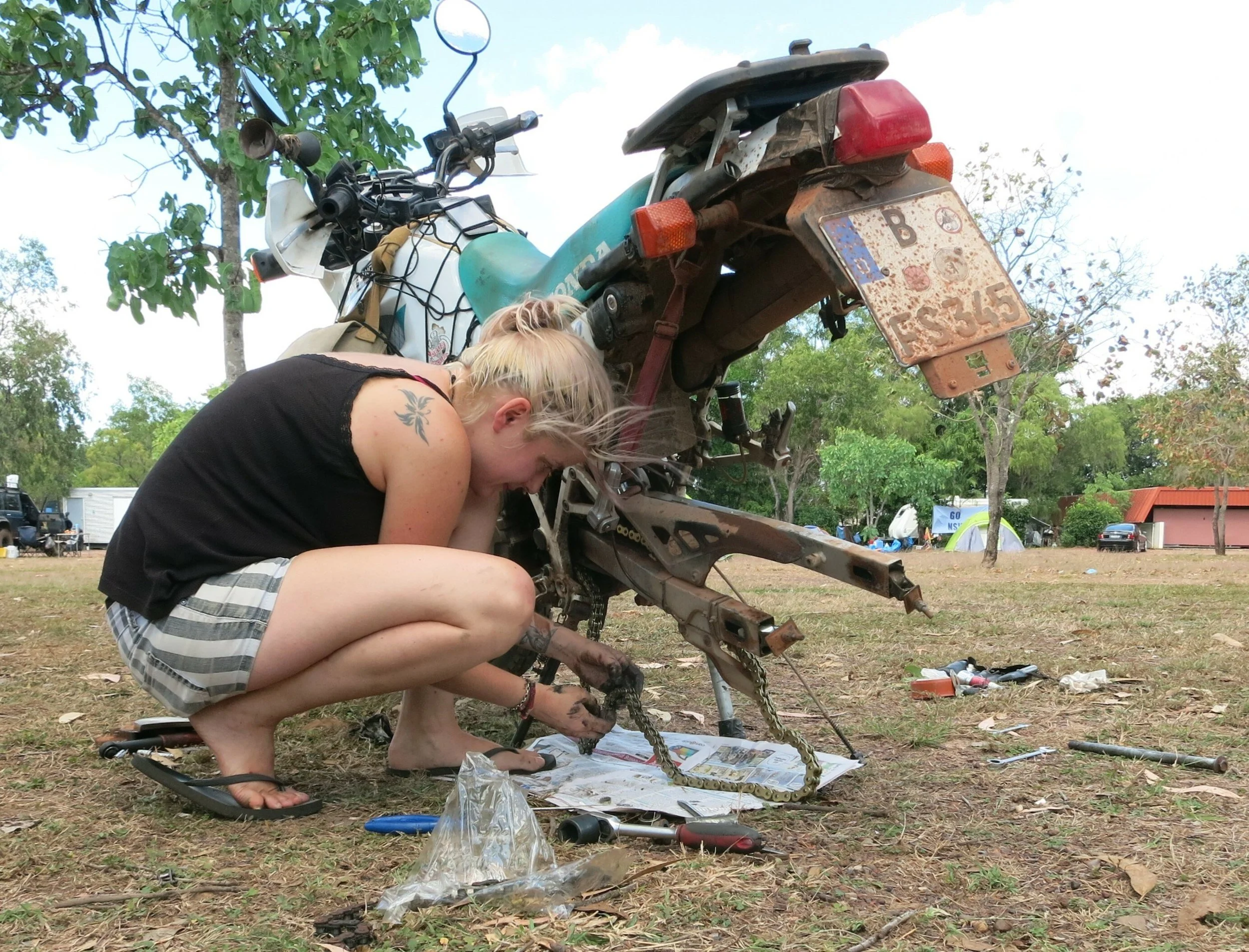Skunk’s tips on how to de-winterize a motorcycle
Spring is in the air, and it’s time to wake up the bike! I know, it’s so tempting to just pop the key in the ignition, and see if the bike will start. I’ve seen Maria do it, and most of the time, her reliable lil Honda NX250 will actually fire up with fairly little persuasion. But of course there is something to be said for reconnecting with your trusty steed after a long period of abstinence, and making sure it’s fighting fit for a fantastic riding season.
So plan to take your time, maybe make a day of it. You’ll need some good music, a beer (or a cuppa, if you prefer), the usual tools for your bike and some stuff to clean it with. Your service manual and maintenance schedule might also come in handy.
Visual check-over
Apart from reminding yourself what the bike actually looks like, it is also a good idea to check for insects and rodents. The little critters love to overwinter in mufflers, air intakes and under the seat. If they have, persuade them to move out, clean up and inspect for any damage such as gnawed cables.
Also check for tell-tale puddles under the bike and look for leaks.
Clean the bike
Now, it isn’t strictly necessary to clean the bike, but I find it is a great way to settle into the groove and closely inspect everything, looking for loose bolts, cracked rubber seals and the like.
Battery
Do this now, so it has time to charge while you do the rest of the work, if necessary. Take a reading with a multimeter. 12.7V and above should definitely be good for most bikes, but it depends on your bike. The NX usually manages to fire up with anything above 11.9V, so long as Maria doesn’t have to crank too long. If it’s too low, charge the battery.
To remove the battery, make sure the bike is switched off. Disconnect the negative (black) terminal first. When reconnecting, connect the positive (red) terminal first.
While you’re at it, inspect the battery for corroded terminals, bulges and leaks. If it is not a maintenance-free battery, you might want to check the fluid level and top it up as per the manufacturer’s instructions.
Spark Plugs
The spark plugs should be rust and corrosion-free and the gap the correct size.
This is also a good time to check for deposits like oil or black soot, as they can indicate upcoming larger problems like a badly adjusted carburettor, leaking valve seals or worn piston rings. It’s not usually a reason to panic - the NX keeps on running for quite some time before it markedly loses power. But it’s good to know that those larger maintenance items are coming up, especially if you’re planning a bigger motorcycle trip.
Air Filter
You might get by without changing this - Maria often has. But then she has to import them from Europe. (The joys of vintage bikes.) The winter air can be quite damp, turning whatever dust was already in the filter into suffocating goo. So why not treat your bike to a fresh one for the new riding season?
Coolant
Check the level. And if it’s too old, best replace it for the season, flushing any gunk out of the system while you’re at it.
Oil
Obviously leave the oil and filter change until after the engine is hot. But you definitely want to be sure there is at least some oil in there, before you start up the engine.
Fuel
Now, the NX will fire up on almost any old crap. Some bikes are more sensitive. So if it’s very old, consider swapping it out. If you don’t, firing up the first time may be a little harder and you can expect some loss of performance until you’ve topped up with new gas a couple of times. Some people chose to use cleansing fuel additives to the first couple of tankfuls.
Start the Bike
It’s tempting, but don’t rev the engine - that’s like asking you to do an intensive kickboxing workout before you’ve opened your bleary eyes in the morning. Let it gently wake up and come up to running temperature first.
There isn’t much you can adjust with fuel injection. Just press the starter button for 10-second bursts (to give the battery time to recover in between).
For carbureted bikes there are a few tricks to adjust the fuel air mixture to help it fire up after a long break:
Open the choke to reduce air intake. Slowly close it as the engine warms up.
If you have a float plunger, you can push it to flood more fuel into the carburetor.
If you have a prime option on your fuel petcock, open it for a few seconds to add fuel into the carburetor.
That said, there is a danger that you flood the carb. It’s a balancing game, so gently persevere until you have coaxed your bike out of its deep slumber.
While the bike is running and slowly getting up to operating temperature, you can check everything else.
Operating Cables
Over winter any grease and gunk can make them stuck. Make sure they operate freely and check for frayed ends and rust. Oil them and replace as needed.
Tires
Standing for a long time can cause old tires to crack and deform, especially if you used the side stand. Check for any cracks or damage, and that you have enough tread left.
Most likely you’ll also have to top up air.
Suspension
Climb onto the bike and bounce around, compressing the suspension. It should operate smoothly without squealing.
Check that the fork seals are in good condition and that no liquid is escaping from neither front and nor rear suspension.
Brakes
While you’re up there, apply the brakes and make sure they’re working properly. Check that they also release properly. Replace the brake pads if needed.
Check that no brake fluid is escaping and that the fluid is clear. Top up or replace as necessary using a new, unopened bottle. (Once opened, left-over brake fluid absorbs moisture from the air and becomes less effective.)
Drive Chain (if you have one)
Check for rust and seized links. Clean, adjust tension and lube as needed. This is also a good time to see when you’ll need a new chain and sprockets.
Oil and Filter change
By now the bike is probably hot and the cooling fan has been running (great, you know it still works properly). So now it’s time to change out the oil and filter. Just watch out, the oil will be scaldingly hot and might come spewing out.
Go for a long ride
Feels good, doesn’t it? Being properly re-acquainted with your bike and knowing it’s in good shape. Time to go for a long, easy-going ride so the engine gets to warm up and all the parts get a gentle but full work-out. Any hidden problems, if there are any, will likely reveal themselves now.
PS: These tips apply pretty much any time you recommission a motorcycle after it has been standing around for a while. Some of the procedures may differ, depending on which motorbike you have, and what you did, when you winterized it.













